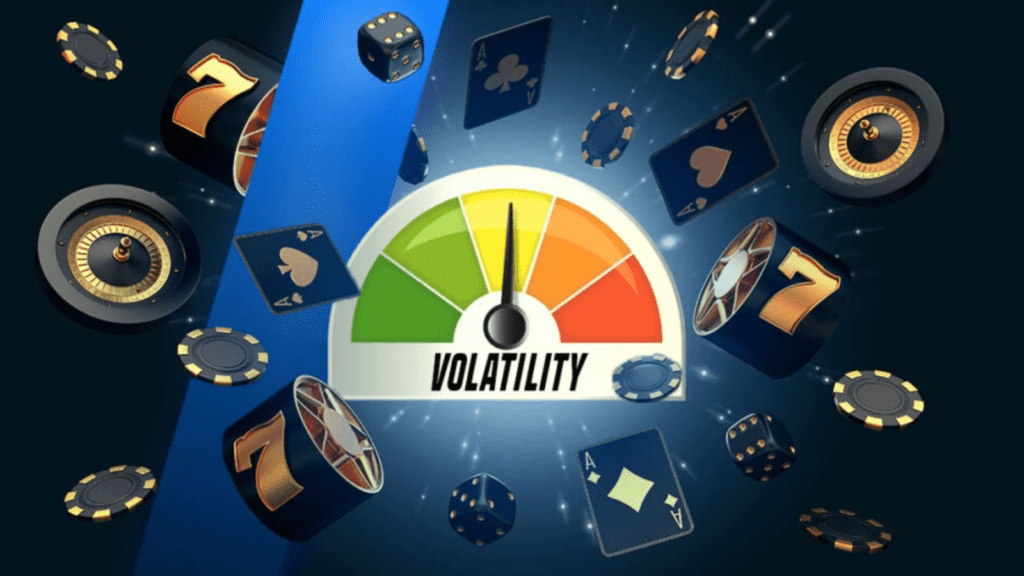By Andrew Burnett
Slot volatility is a key part of your gambling experience. It shows how risky a game is—how often it pays and how big the wins are. High volatility means rare but big wins, while low means smaller wins more often. Knowing this helps you pick the right game for your style and budget. This guide explains what volatility is, how it differs from RTP, the three types (low, medium, high), and how to choose the best slot for you.
What Is Slot Volatility?
Slot volatility means how risky a game is and how often it pays. High volatility means big wins but less often; low means smaller, more frequent wins. It helps you choose the right game for your style.
Volatility Measures Risk, Not Just Reward
Slot volatility shows how often and how much a game pays. Low volatility means small, frequent wins; high volatility means fewer wins but bigger payouts. It helps you understand the game’s style, not its quality. Even with the same RTP, two slots can feel very different based on volatility.
Volatility vs RTP: What’s the Difference?
Many players mix up RTP and volatility, but they’re different. RTP shows how much a slot pays back over time, like 96%. Volatility tells you how often and how big those wins are. High volatility means rare but big wins; low volatility means smaller, frequent wins. Knowing both helps you play smarter. To see how volatility types vary in playstyle and pacing, you can explore slot categories based on volatility level in the next section.
Types of Slot Volatility

Each slot pays out differently based on its volatility. This shows how often and how much you can win. Slots can be low, medium, or high volatility. Knowing this helps you pick a game that matches your risk level and play style.
Low and Medium Volatility Slots Offer Control and Consistency
Low volatility slots give small but frequent wins, making them great for longer, low-risk play. They’re perfect for casual players and beginners. Medium volatility slots mix steady wins with the chance for bigger payouts, offering a good balance. If you’re unsure where to start, medium slots are a safe bet.
High Volatility Slots Deliver Big Risks and Bigger Potential Rewards
High volatility slots are for players who enjoy big risks and big rewards. Wins may be rare, but they can be huge—especially in bonus rounds. These games are best for experienced players or those with a big budget and patience. They’re not ideal for quick play, but they offer some of the most exciting action online.
How Volatility Affects Your Gameplay

Volatility affects how a slot game plays and feels. It impacts your wins, losses, and overall experience. Knowing how it works helps you play smarter and enjoy the game your way.
Emotional Flow and Bankroll Management Depend on Volatility
Low volatility slots give frequent small wins, making play smoother and less stressful—great for casual play and smaller budgets. High volatility slots offer bigger wins but come with longer dry spells and higher risk. They’re exciting but need discipline and smart money management to enjoy safely.
Session Dynamics and Bonus Behavior Are Defined by Risk Level
Volatility shows how often and how much you win. Low to medium volatility slots pay small, frequent wins for steady play. High volatility slots pay big but rare wins, great for risk-takers.
How to Identify a Slot’s Volatility
Knowing a slot’s volatility helps you pick the right game and avoid losing money too fast. You can check a game’s risk online or before playing. This way, you can choose games for fun, steady wins, or big jackpots.
Use Game Details, Reviews, and Providers to Gauge Volatility
Most trusted slot providers show volatility as low, medium, or high in the game info or paytable. Developers like Pragmatic Play and NetEnt share this clearly. You can also check casino reviews and player forums for details. Slot comparison sites often list volatility with RTP and bonus info to help you choose wisely.
Watch for Gameplay Cues and Test with Demo Versions
If a slot doesn’t show volatility, you can guess from its design. Big wins and rare bonuses mean high volatility. Frequent small wins mean low volatility. The best way to learn is by playing free demos, which most casinos offer. This lets you see how the game plays without risking money.
Choosing the Right Volatility for Your Playstyle

Slot games fit different styles. Some like slow play with small wins, others go for big jackpots. Knowing your risk and goals helps you pick the right game and volatility.
Align Volatility With Your Budget and Playing Goals
Low volatility slots are best for longer play on a small budget, giving steady wins and easy gameplay for beginners. Medium volatility offers a balance of fun and risk with moderate wins, great for regular players. High volatility suits risk-takers, offering big rewards but with dry spells, ideal for experienced or high-roller players.
Examples of Slot Games by Volatility Type
For low volatility, try games like Starburst or Aloha! Cluster Pays for frequent small wins. Medium volatility games like Book of Dead or Reactoonz offer a balance of wins and features. High volatility slots like Dead or Alive II or Money Train 4 suit players chasing big bonuses.
Conclusion
Volatility shows how a slot plays and pays out. Low volatility means steady wins, while high volatility means bigger but rarer wins. Know your risk level and budget to pick the right game. Try free demos first to find what suits you best.




